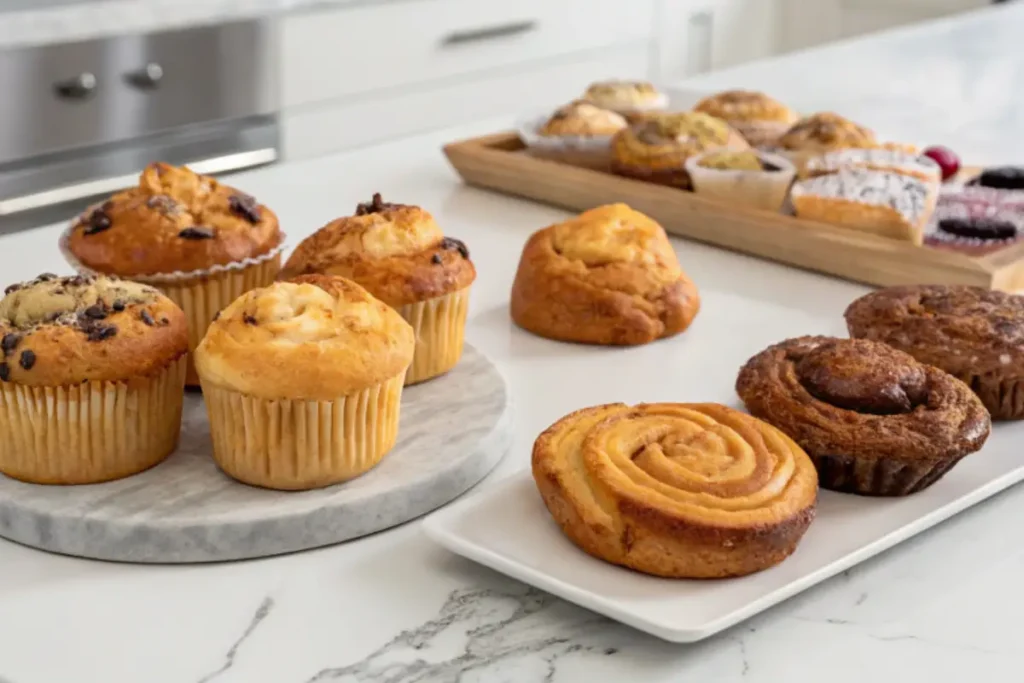1. Introduction
How long do breakfast pastries last? If you’ve ever opened a bakery box in the morning only to find your favorite croissant or Danish losing its soft, flaky allure, you’ve likely pondered the best way to store these treats. Nothing beats a fresh, warm pastry alongside your morning coffee. But if those goodies aren’t stored properly or consumed in time, you might have to deal with soggy, stale, or even spoiled bites.
In this comprehensive guide, we’ll uncover exactly how long your breakfast pastries can remain fresh, the factors that influence shelf life, and expert tips for storing, reheating, and repurposing them. By the end, you’ll know how to make every last crumb count—whether it’s a homemade pastry brimming with love or a convenient store-bought variety ready at a moment’s notice.
2. Defining Breakfast Pastries
Before diving into storage methods, let’s clarify what we mean by breakfast pastries. This category generally includes all those sweet or savory dough-based delights that pair exceptionally well with your morning routine. Think of croissants with their delicate, buttery layers, Danishes with fruity or cheesy centers, cinnamon rolls crowned with a sweet glaze, warm muffins bursting with berries or chocolate chips, and flaky scones meant to be enjoyed with jam and butter.
Each breakfast pastries variety offers its own textural and flavor nuances, but what they share is a universal appeal for breakfast or brunch. These delicious pastries can be traced back centuries; bakers around the world have continually refined pastry-making techniques to heighten flavor and texture. From a Parisian boulangerie to a bustling American bakery, breakfast pastries have stood the test of time.
Since they’re made to delight the senses, it’s no surprise that many people ask, “How long do breakfast pastries last?”Understanding their shelf life ensures you can enjoy these baked treats at their freshest while avoiding waste.
3. Factors Influencing Shelf Life

When pondering how long do breakfast pastries last, several components play key roles in extending or reducing their life span. Understanding these factors helps you strategize storage and ensure maximum freshness.
1. Ingredients
One of the biggest determinants of shelf life is what goes into the pastry. If the recipe calls for perishable ingredients like dairy, eggs, fresh fruit, or cream cheese filling, the pastries are more susceptible to spoilage. Store-bought pastries sometimes contain preservatives that lengthen their usable life. Homemade pastries, on the other hand, often skip preservatives, which can reduce their longevity but may result in superior taste and quality.
2. Moisture Content
Moisture is a double-edged sword in baking. While a moist interior can contribute to a delectable mouthfeel, it also means a faster spoilage rate. Cream-filled pastries or fruit-laden danishes tend to develop mold or off-flavors sooner than dry pastries like plain scones or croissants.
3. Packaging & Environment
Breakfast pastries are sensitive to humidity, temperature changes, and exposure to air. The more a pastry is exposed to open air or heat, the quicker it becomes dry or stale. Conversely, storing them in conditions that are too humid can hasten mold growth. Properly sealed containers help maintain freshness and texture.
4. Storing Breakfast Pastries Properly
Now that we’ve explored the major factors at play, let’s cover the best ways to store these scrumptious morning treats.
Room Temperature Storage
If you plan on eating your breakfast pastries within a day or two, room temperature is perfectly acceptable—provided you handle them correctly. Here’s how:
- Choose the right container: Use a pastry box, paper bag, or breathable container. Storing them in airtight plastic can trap moisture, leading to sogginess for some pastries. However, certain pastries like muffins and loaf cakes benefit from tighter seals because they’re less likely to become soggy and more prone to drying out.
- Keep away from sunlight: Direct sunlight can create warmth inside your container and accelerate spoilage or staling.
- Consume within 2 days: Beyond this point, pastries often lose their best flavor and texture.
Although many pastries are safe to leave on the counter for a short duration, always be mindful of any cream cheese or dairy-based icing. Those require cooler temperatures to prevent bacterial growth.
Refrigeration
To extend the life of pastries that contain perishable ingredients—like custard, fruit fillings, or whipped cream—refrigeration becomes crucial. Follow these tips to maintain taste and quality:
- Wrap them individually: Use plastic wrap, aluminum foil, or place each pastry in its own sealed bag. This prevents flavors and odors from circulating around the fridge.
- Use a dedicated container: If you’re stacking pastries, separate layers with parchment paper to avoid sticking.
- Enjoy within 3–5 days: This is a general guideline; pastries with high dairy content might have a shorter window.
Remember that the cold environment of a refrigerator can sometimes dry out baked goods. Let them rest at room temperature for a few minutes or reheat them gently to restore some of their original softness.
Freezing
If you won’t be enjoying your pastries for a while, freezing is the best option. Properly frozen pastries can retain much of their texture and flavor for up to two or even three months.
- Cool them completely: Ensure your pastries are at room temperature before freezing to prevent condensation, which can cause freezer burn.
- Wrap tightly: Double-wrap pastries in plastic and place them in a freezer-safe container or zip-lock bag. Removing as much air as possible is key to preventing ice crystals from forming.
- Label and date: Always note the freezing date so you can track how long they’ve been in cold storage.
When you’re ready to indulge, thaw pastries at room temperature for around an hour, or reheat them directly from frozen using an oven or toaster oven for a crisp, fresh-baked taste.
5. Differences Between Homemade and Store-Bought Pastries
You may wonder, “Do homemade pastries last as long as their store-bought counterparts?” The answer often depends on added preservatives and packaging techniques.
1. Preservatives & Additives
Commercial bakeries commonly add certain preservatives to lengthen shelf life. This keeps pastries looking and tasting good on the store shelf for several days. Homemade pastries typically skip these chemicals, which is appealing for those who want cleaner ingredients. The trade-off is that homemade treats can go stale or spoil faster.
2. Taste & Texture
Many pastry enthusiasts agree that homemade goodies offer a richer, more nuanced flavor, especially if made with real butter, fresh dairy, or fruit. While store-bought pastries can still be quite tasty—especially from high-quality bakeries—the difference in texture and aroma is often noticeable.
3. Best of Both Worlds
If convenience is paramount, store-bought pastries may be your go-to. Just be mindful of their packaging and any instructions on the label. If you enjoy the craft and prefer minimal additives, try homemade pastries. You can still store and freeze them effectively. In both cases, carefully planning your storage method is the surest way to extend their life.
6. How to Reheat Breakfast Pastries
One of the greatest pleasures in life is biting into a freshly warmed pastry. Let’s look at three ways to reheat pastries without sacrificing flavor or texture.
Oven Method
- Preheat your oven to around 300°F (150°C).
- Wrap pastries loosely in aluminum foil, especially if they have a glaze or cheese on top to prevent burning.
- Heat for 5–10 minutes, depending on pastry size.
- Check crispness: If you want a crusty exterior (e.g., for croissants), remove the foil in the last few minutes of heating.
Reheating pastries in the oven revitalizes them beautifully, especially if they were frozen or sitting in the fridge. The circulating dry heat helps restore crisp layers and maintain a warm, pillowy interior.
Microwave Tips
While microwaving isn’t always recommended for layered pastries (because they can turn soggy or chewy), it’s still a handy method for a quick reheat:
- Place the pastry on a microwave-safe plate.
- Heat in short, 10-second bursts to avoid overheating.
- Check texture: Some pastries may harden as they cool. Consume them while they’re still warm.
For items like muffins or certain loaf cakes, the microwave often works well, offering a soft, moist bite.
Toaster Oven or Air Fryer
If you have a toaster oven or air fryer, you can quickly reheat pastries without losing crispness:
- Toaster Oven: Set to about 325°F (160°C), place pastry on the rack or tray for 3–5 minutes.
- Air Fryer: Preheat to 320°F (160°C) and heat pastries for 3–5 minutes. Keep an eye out for browning.
7. Telltale Signs a Pastry Has Gone Bad
No matter how well you store your pastries, they won’t last forever. Learn to spot when it’s time to toss them to avoid any health risks.
1. Visual Indicators
Check for mold growth, which might appear as green, white, or bluish spots. Also, watch for odd color shifts—like a darkening crust or discolored filling.
2. Taste & Smell
If you notice a sour, rancid, or simply off smell, it’s safer to discard the pastry. The same goes for flavor: Any bitterness or strange aftertaste signals the pastry is no longer safe.
3. Changes in Texture
An overly dry or rock-hard pastry might not always be unsafe, but if there’s an unusual sliminess or stickiness, it indicates potential spoilage.
When in doubt, throw it out. The minimal cost of a lost pastry far outweighs the health risks from consuming spoiled food.
8. Creative Ways to Use Leftover Pastries

You might find yourself with pastries nearing the end of their prime. Don’t toss them just yet! Here are some clever ideas to breathe new life into slightly stale or day-old treats.
- Bread Pudding: Cinnamon rolls or croissants are perfect for bread pudding. Tear them up, soak in a custard mixture, and bake until golden. The result is a luxurious dessert or brunch item.
- French Toast: Leftover pastries can make decadent French toast. Dip slices in an egg-and-milk mixture, then fry to golden perfection.
- Trifles or Parfaits: Layer crumbled pastries with whipped cream, fruit, or pudding in a glass to create an elegant dessert. This works especially well if you have muffins or scones.
- Savory Twists: If you have plain croissants or scones, transform them into savory bites by adding cheese, ham, or scrambled eggs, then warming them in an oven.
9. Frequently Asked Questions About how long do Breakfast Pastries last?
How long are pastries safe to eat?
In general, pastries are safe to eat for about 1–2 days when stored at room temperature in a proper container. Refrigerated pastries typically remain safe for up to 5 days, especially if they contain dairy or fruit fillings. To maintain taste and texture, consume them within the first few days.
How long does a breakfast bake last in the fridge?
A breakfast bake, often made with eggs, milk, cheese, and pastries or bread pieces, can last for around 3–4 days in the fridge. Ensure it’s wrapped or sealed well to prevent the introduction of odors or bacteria. Always check for signs of spoilage such as an off-smell or discoloration before reheating and serving.
How long do pastries last unrefrigerated?
Most pastries can last 1–2 days unrefrigerated if they’re protected from air and moisture, especially varieties without perishable fillings. However, pastries with cream cheese or custard-based fillings should not be left out for more than a few hours to minimize bacterial growth.
How long can you keep baked pastry?
When refrigerated, baked pastry can generally last up to 5 days, though the exact time varies based on the type of pastry, the filling, and the storage conditions. Freezing can extend a pastry’s life to about 2–3 months. Always thaw or reheat properly to enjoy the best flavor and texture.
10. Conclusion
From the buttery aroma of a freshly baked croissant to the sweet burst of fruit in a warm Danish, pastries hold an undeniable place in our breakfast routines. Knowing how long do breakfast pastries last is the key to savoring every bite without compromise. By paying attention to factors like moisture, ingredients, and storage methods, you can keep your pastries fresher for longer. Whether you’re partial to homemade delights or convenient store-bought snacks, proper wrapping, refrigeration, or freezing can significantly extend their shelf life.
Feel free to put these tips into practice the next time you bring home a bakery box or whip up a batch of pastries in your kitchen. If you’re left with day-old breakfast pastries, don’t forget the creative ways to repurpose them—turning potential waste into a culinary adventure.
Now that you know how long do breakfast pastries last, you can confidently store, reheat, and even freeze your favorite treats without worrying about them going stale too soon. Whether you enjoy breakfast pastries fresh from the oven or want to extend their shelf life, proper storage techniques will keep them delicious for days.
So go ahead—treat yourself to that second croissant (or third!) and savor every bite. How long do breakfast pastries last? With the right storage hacks, they can last longer than you think—so you never have to waste a single flaky layer!

